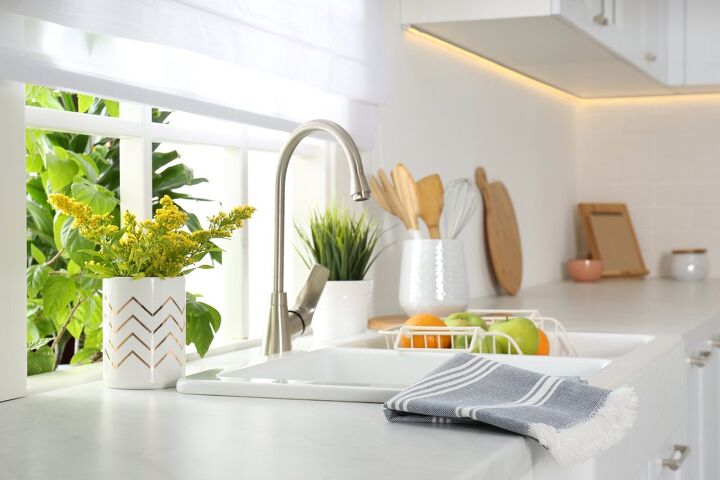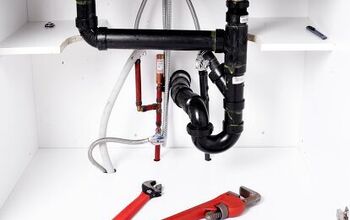Kitchen Sink Dimensions and Guidelines (with Drawings)

Kitchen sinks are among the most useful plumbing fixtures of any home. They serve many purposes, ranging from hand-washing to heavy-duty dishwashing and appliance cleaning. Therefore, you’ll find various styles and kitchen sink dimensions equipped to meet your individual needs.
Kitchen sinks typically come in three sizes: small (roughly 14 ⅝” by 15 ¾”), medium (roughly 21 ⅛” by 15 ¾”), and large (roughly 28 ⅞” by 15 ¾”). Regardless of size, all kitchen sinks should be at least 7 to 7.25 inches deep. Popular kitchen sink styles are drop-in sinks, undermount sinks, farmhouse sinks, and workstation sinks. All of these designs can be customized according to size.
With so many options to choose from, it can feel overwhelming to decide which sink design will best fit your kitchen needs. By identifying the primary use of your kitchen sink, it will be easier to narrow down which style will serve you best. Read on to learn which of these sink sizes and styles will be the optimal choice for your kitchen.
Common Kitchen Sink Dimensions
There are many considerations to factor in when determining which size sink you will need. The wrong kitchen sink can be a major nuisance. For example, a too-small sink will fill up with dishes too quickly and feel cramped.
On the other hand, a sink that is too large will take up too much counter space. It’s important to determine the right measurements for your sink needs to avoid the consequences of the wrong sink size.
Regardless of which style you choose, kitchen sinks typically come in either a small, medium, or large size.
Best Sink Sizes For Small Kitchens
If you have a small kitchen or kitchenette (typically 70 square feet or less), you may want to consider installing a small kitchen sink. An oversized sink in a small kitchen will feel cumbersome and in the way.
Small kitchen sinks are typically 14 ⅝ inches in width by 15 ¾ inches in length but are sometimes made up to 22 inches in length. Sinks of this size usually have a single bowl and are perfect for studio apartments and tiny houses.
Small kitchens can also accommodate sink styles designed to save space, such as wall-mounted sinks or round sinks. It helps save space and looks great in small kitchens. Below is a blueprint for the dimensions of a round sink.
Best Sink Sizes For Mid-Sized Kitchens
Medium kitchen sinks are typically 21 ⅛ inches by 15 ¾ inches or slightly larger, up to 27 inches. These sinks are a great choice for mid-sized kitchens. A mid-sized kitchen is around 100-200 square feet.
Medium-sized sinks are considered “standard size” and ideal for household use, such as dishwashing and cooking clean-up. Medium kitchen sinks can be either single or double-bowl.
Best Sink Sizes For Large Kitchens
The dimensions of large kitchen sinks are 28 ⅞ inches wide by 15 ¾ long are larger, depending on the design. These sinks are a great fit for large kitchens, which are roughly 200 square feet or more. Large kitchens are spacious and have ample counter space, making them perfect for a range of large kitchen sink designs.
You should consider installing a large sink if you want to maximize the space available in your sizable kitchen. Another benefit of having a large kitchen sink is that you have the option of installing upgrades in the future.
Some common kitchen sink upgrades are:
- Spray faucets
- Water filters
- Strainers
- New plumbing
- Organization accessories
Which Kitchen Sink Design Should I Get?
The most popular kitchen sink designs include drop-in sinks, undermount sinks, farmhouse sinks, and workstation sinks. Ranging from practical to aesthetically pleasing, these sinks serve a variety of purposes for all types of kitchens.
Drop-in Sinks
A drop-in sink–also known as a top-mount sink–is a particularly popular kitchen sink style. The drop-in sink is very easy to install as it simply “drops” into a pre-cut hole on the countertop.
The edges of the sink rest on the counter for stability. A favorite of many, you can replace drop-in sinks easily without disturbing the countertop or any plumbing.
Drop-in sinks work well for all types of countertops and average about $150. They are also considered the easiest to install and cheapest of all popular sink styles.
Undermount Sinks
Undermount sinks differ from drop-in sinks as you install them from under the counter rather than above it. An undermount sink does not have edges that rest on the countertop. Instead, they have a hidden rim attached under the counter.
This makes for easier cleanup than a drop-in sink. Undermount sinks are a great choice if you want to optimize counter space. They are particularly ideal for solid surfaces and granite countertops.
The installation cost for undermount sinks is marginally higher than drop-in sinks as the price is roughly $50 to $75 more.
Farmhouse Kitchen Sink Dimensions
Farmhouse sinks, also known as apron sinks, have a wide expanse and a deep bowl with an exposed front. These are very versatile sinks that come in a wide range of materials.
Farmhouse sinks can average 18 to 20 inches deep and anywhere from 20 to 60 inches long. They are usually roughly 8 to 10 inches deep.
Farmhouse sinks are considered ideal for heavy-duty cleaning, such as cleaning large pots and pans. These sinks are very large, and you can use them for a multitude of purposes, such as washing laundry and storing water.
It’s important to keep in mind that a certain type of base cabinet is required to support a farmhouse sink. However, you can modify some styles to fit your existing cabinets. You can expect to pay around $250 to $500 to install a farmhouse sink, depending on the style and necessary retrofitting.
Included below is a diagram of the sample dimensions of a farmhouse sink.
Workstation Kitchen Sink Dimensions
The largest and most industrial of the designs listed, you primarily see workstation sinks in restaurants. However, it’s common to use workstation sinks residentially, especially if you do lots of work in the kitchen.
A great feature of these sinks is that you can convert your kitchen sink into an efficient work/prep space. With custom accessories such as cutting boards, drying trays, and colanders, workstation sinks are a great choice for multi-tasking kitchen users.
Workstation sinks vary in size but are usually 30 to 33 inches long. Additionally, they are roughly 16 to 22 inches wide and have a bowl at least 10 inches deep. The typical installation cost for a workstation sink ranges from $400 to $1,000.
Other Factors To Consider About Your Kitchen Sink Size
The guidelines above should provide a helpful start in deciding which sink will best benefit your kitchen and lifestyle. Listed below are a few more factors you should consider before finalizing the choice of your ideal kitchen sink.
Single-Bowl vs. Double-Bowl Kitchen Sinks
Single-Bowl Sinks —A single-bowl sink has one basin with no dividers. This style of sink has increased in popularity over recent years.
Single-bowl sinks are a wise choice for kitchens with limited counter space; they typically measure about 28 to 30 inches long. These sinks are generally pretty roomy, making them great for washing large pots and pans.
Double-Bowl Sinks — Double-bowl sinks have two basins separated by a divider. Traditionally, both basins are an equal size; however, more modern designs come in various shapes and configurations.
With these designs, one basin–typically the smaller one–can be more shallow than the other. (See the diagram below for examples of how you can divide double-bowl basins.)
Double-bowl sinks are the optimal choice for efficiently washing dishes by hand. This is particularly helpful in kitchens without a dishwasher. Plus, double-bowl sinks make for easy separation of clean and dirty dishes during food prep.
On average, double-bowl sinks at least 48 inches long, with some larger units measuring at least 60 inches in length.
The Pros And Cons Of A Deeper Kitchen Sink
The important factor to keep in mind when considering a deeper sink is your height. Typically, kitchen sinks are 7 to 7.25 inches in depth, rarely exceeding 8 inches. However, some sinks on the market are two to three inches deeper than this standard size.
If you are taller, a deeper sink means you must bend more to reach the bottom. This can put a real strain on your back. On the other hand, shorter people will likely not be phased by this extra depth and may find it beneficial.
Can I Use A Utility Sink As A Kitchen Sink?
You most commonly find utility sinks in laundry rooms, they are often called “double-duty” sinks. This is due to their frequent use for both kitchen and laundry purposes. Finished laundry areas have become increasingly popular, and many utility sinks are beautifully designed, making them perfect for kitchen use.
What Is The Best Material For A Kitchen Sink?
The right material is an essential aspect of choosing your ideal kitchen sink. There are many materials to choose from, such as stainless steel, porcelain, cast iron, copper, and many more.
Ask yourself how much you will use the sink and how frequently you plan to clean it. Materials such as porcelain are prone to stains and scuffing from abrasive cleaning.
If you plan to use your sink for heavy-duty purposes, you may want to opt for stainless steel or cast iron. Not only are these sinks modern and sleek, but they hold up against damages and are easy to clean.
What Size Kitchen Sink Works For You?
Based on your kitchen style and size, you can choose a small, medium, or large kitchen sink. Small kitchen sinks average 14 ⅝” by 15 ¾”, medium sinks are roughly 21 ⅛” by 15 ¾”, and large ones are about 28 ⅞” by 15 ¾”. You should get a sink at least 7 inches deep, although going a bit deeper will help you avoid water splashing back up in your face. You can also customize a variety of kitchen sink styles to a size that works best for you.

Stacy Randall is a wife, mother, and freelance writer from NOLA that has always had a love for DIY projects, home organization, and making spaces beautiful. Together with her husband, she has been spending the last several years lovingly renovating her grandparent's former home, making it their own and learning a lot about life along the way.
More by Stacy Randall
























![Cost To Drill A Well [Pricing Per Foot & Cost By State]](https://cdn-fastly.upgradedhome.com/media/2023/07/31/9074980/cost-to-drill-a-well-pricing-per-foot-cost-by-state.jpg?size=350x220)






